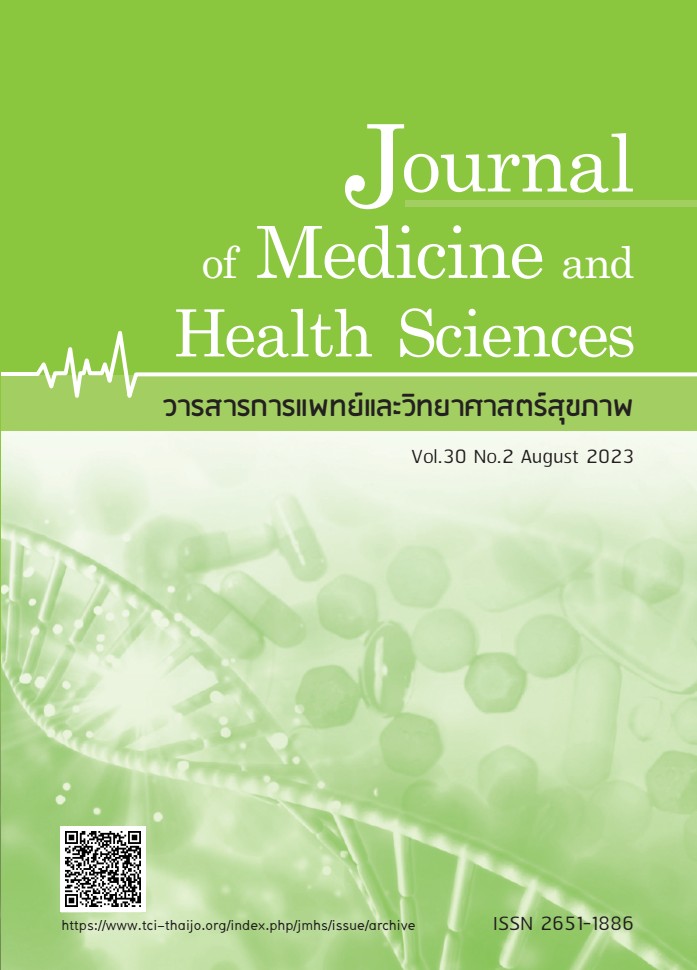The potential role of fungal Quorum-sensing, Tryptophol, in human pathogenic fungi focusing on systemic mycosis
Keywords:
A549 cells, Cell toxicity, Quorum-sensing molecules, TryptopholAbstract
Tryptophol, a quorum-sensing molecule (QSM), is a secondary metabolite secreted from yeast. Recent studies have suggested anti-fungal activity against pathogenic fungi. This study aims to determine the activity of tryptophol against the growth of invasive pathogenic fungi, including Histoplasma capsulatum, Talaromyces marneffei, Aspergillus fumigatus, Cryptococcus neoformans, Candida parapsilosis, and Lodderomyces elongisporus and to study the cytotoxicity on A549 lung cancer cells. The lowest MIC and MFC values of H. capsulatum, T. marneffei, A. fumigatus, C. neoformans, C. parapsilosis, and L. elogisporus were MIC 6.25, 3.12, 25, 3.12, 12.5, and 12.5 mM and MFC 50, 3.12, 50, 6.25, 25, and 25 mM, respectively. The cytotoxic effect of tryptophol on A549 cells at the concentration of 3.12 and 31.2 mM for 24 h were determined. Cell viability was 98.94% and decreased to 1.09% after treated with a higher concentration of tryptophol, as determined by using trypan blue staining. Percentage of cell cytotoxicity was 66.31± 2.91 and 6.30 ± 0.28% in 3.21mM and 31.2mM (10 folds of MIC) of Tryptophol, respectively, which determined using MTT (3-(4,5-dimethylthiazol-2-yl)-2,5-diphenyltetrazolium bromide) assay. The induction of cell apoptosis by tryptophol, was determined using acridine orangeethidium bromide (AO/EB) staining and examined under fluorescence microscope. The results showed that tryptophol exhibited anti-fungal properties, although it induced A549 cell cytotoxicity and apoptosis by 11% and 93%, respectively.
References
Shapiro RS, Robbins N, Cowen LE. Regulatory circuitry governing fungal development, drug resistance, and disease. Microbiol Mol Biol Rev 2011;75(2):213-67.
Denning DW and Hope WW. Therapy for fungal diseases: opportunities and priorities. Trends Microbiol 2010;18(5):195-204.
Havlickova B, Czaika VA, Friedrich M. Epidemiological trends in skin mycoses worldwide. Mycoses 2008;51:2-15.
Brown GD, Denning DW, Gow NA, et al. Hidden killers: human fungal infections. Sci Transl Med 2012;4(165):165rv13.
Brown GD, Denning DW, Levitz SM. Tackling human fungal infections. Science 2012;336(6082):647.
Pumirat P, Tunyong W, Luplertlop N. Medical mycology. J Med Health Sci 2013;20:31-44.
Mutual selfcare. antifungals [Internet]. - [cited 2022 Apr 10]. Available from: http://mutualselfcare.org/medicine/medicative/antimycotics.aspx?M=k&G=a
Wow skin science. Candidiasis Yeast Infection on Skin: How Is it Caused and How to Treat It? [Internet]. c2021 - [cited 2022 Apr 10]. Available from: https://wowskinscience.com/blogs/news/candidiasis-yeast-infection-on-skin-how-is-it-caused-and-how-to-treat-it
The Lecturio Medical Concept Library. Azole. [Internet]. C2021 – [cited 2022 Apr 10]. Available from: https://www.lecturio.com/concepts/azoles/
Borgers M. Mechanism of action of antifungal drugs, with special reference to the imidazole derivatives. Rev Infect Dis 1980;2(4):520-34.
Padder SA, Prasad R, Shah AH. Quorum sensing: a less known mode of communication among fungi. Microbiol Res 2018;210:51-8.
Mosmann T. Rapid colorimetric assay for cellular growth and survival: application to proliferation and cytotoxicity assays. J Immunol Methods 1983;65(1-2):55-63.
Freydière AM, Guinet R. Rapid methods for identification of the most frequent clinical yeasts. Rev Iberoam Micol 1997;14(3):85-9.
Garg A, Sharma GS, Goyal AK, et al. Recent advances in topical carriers of anti-fungal agents. Heliyon 2020;6(8):e04663.
Vanittanakom N, Cooper Jr CR, Fisher MC, Sirisanthana T. Penicillium marneffei infection and recent advances in the epidemiology and molecular biology aspects. Clin Microbiol Rev 2006;19(1):95-110.
Walsh TJ, Pizzo A. Treatment of systemic fungal infections: recent progress and current problems. Eur J Clin Microbiol Infect Dis 1988;7(4):460-75.
University of ADELAID. Mycoses. [Internet]. C2021 – [cited 2022 Apr 10]. Available from: https://www.adelaide.edu.au/mycology/mycoses
Souza AC, Amaral AC. Antifungal therapy for systemic mycosis and the nanobiotechnology era: improving efficacy, biodistribution and toxicity. Front Microbiol 2017;8:336.
Perlin DS, Rautemaa-Richardson R, Alastruey-Izquierdo A. The global problem of antifungal resistance: prevalence, mechanisms, and management. Lancet Infect Dis 2017;17(12):e383-92.
Wongsuk T, Sukphopetch P. Effect of Quarum Sensing Molecules on Aspergillus fumigatus. Walailak J Sci & Tech 2020;17(4):348-58.
Kitisin T, Muangkaew W, Ampawong S, et al. Tryptophol coating reduces catheter-related cerebral and pulmonary infections by Scedosporium apiospermum. Infect Drug Resist 2020;13:2495-2508.
Tamura T, Asahara M, Yamamoto M, et al. In vitro susceptibility of dermatomycoses agents to six antifungal drugs and evaluation by fractional inhibitory concentration index of combined effects of amorolfine and itraconazole in dermatophytess. Microbiol Immunol 2014;58(1):1-8.
Adimi P, Hashemi SJ, Mahmoudi M, et al. In-vitro Activity of 10 Antifungal Agents against 320 Dermatophytes Strains Using microdilution method in Tehran. Iran J Pharm Res 2013;12(3):537-45.
Baygar T, Sarac N, Ugur A, et al. Antimicrobial characteristics and biocompatibility of the surgical sutures coated with biosynthesized silver nanoparticles. Bioorg Chem. 2018;86:254-8.
Sibiya MA, Raphoko L, Mangokoana D, et al. Induction of Cell Death in Human A549 Cells Using 3-(Quinoxaline-3-yl) Prop-2-ynyl Methanosulphonate and 3-(Quinoxaline-3-yl) Prop-2-yn-1-ol. Molecules 2019;24(3):1-16.
Downloads
Published
How to Cite
Issue
Section
License

This work is licensed under a Creative Commons Attribution-NonCommercial-NoDerivatives 4.0 International License.



